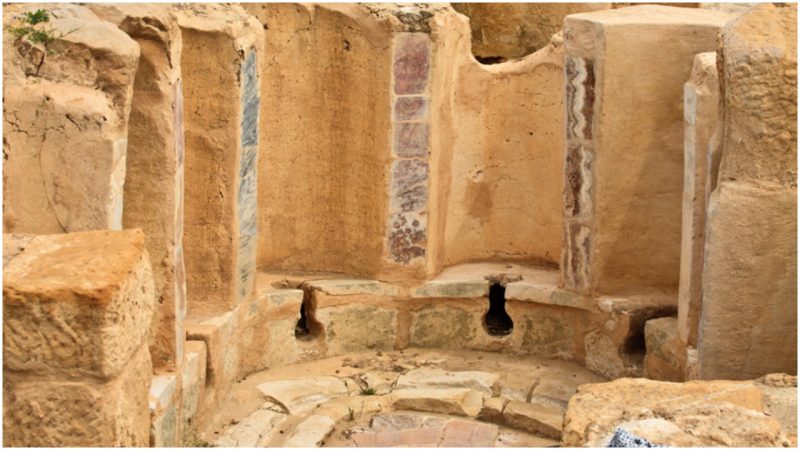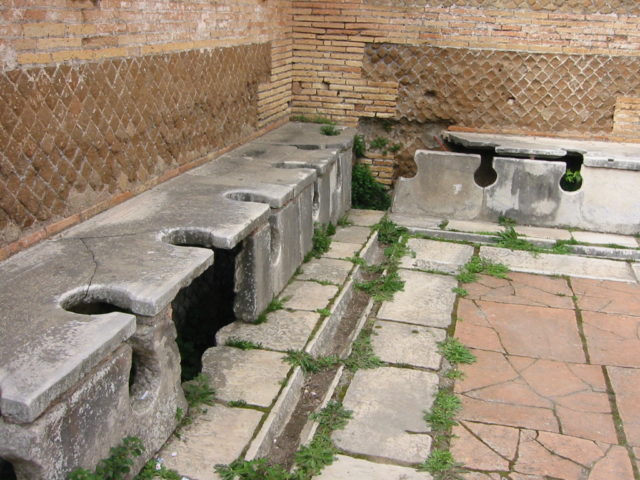
There is no doubt about the importance of ancient Roman advances in science, technology, and philosophy. On the other hand, some aspects of their lifestyle and habits remain controversial.
The ancient Roman Empire was truly a force to be reckoned with. Through their monumental efforts, the Romans managed to conquer a huge territory and unify it with law, architecture, and art. Today, we still benefit from the knowledge they left us.
But a closer view of the evidence about their day to day life reveals behavior that was far from glamorous. It turns out that some of the things they did would be considered as disgusting and unethical today. Here are some of the worst:
Public toilets were a dangerous place to be in

Ancient Roman latrines (latrinae) in Ostia Antica.
It seems that Roman toilets were a terrifying and deadly place; people even used magic to get out of them alive. Public toilets in Ancient Rome were the exact opposite of their public baths. Whereas baths were relaxed and pleasant places, toilets could be foreboding. The Roman public “throne” was usually a dark hole connected to a sewer channel, opened to all sorts of creatures. Some of the public toilets had even 50 dark holes with no dividers between them.
Danger lurked in every corner. Very often rats (or some other critters) would crawl up the hole and bite the posterior of the unlucky person. Another problem were methane buildups in the sewer. On some occasions, the gas would ignite and expose people to naked flames. It could be an explosive experience.
This is why people all around the empire relied upon magic and superstition for toilet protection. Archaeologists found many magical spells meant to ward off demons etched into lavatory walls. Another thing that demons hated was laughter. People used to carve all sorts of caricatures that helped them laugh while doing their business inside. When the situation was particularly dire, people called on the gods for help. One such goddess was the Roman goddess of luck, Fortuna. An image of Fortuna guarded some of the toilets. It took a long time for the Romans to realize that they needed hygiene, not luck, to stay healthy and safe inside the toilets.
People shared a sponge in public toilets

A replica xylospongium (sponge on a stick). Author: D. Herdemerten ( Hannibal21 ) CC BY-SA3.0
We have already mentioned how dangerous and disgusting the ancient Roman toilets were, but it gets even worse. People back then didn’t have the luxury of toilet paper. Instead, they used all sorts of things for wiping. One of the most common tools was a sponge on a stick.
This dirty tool was called a “xylospongium” and usually there were only a few of them per public toilet, resting in a basin of dirty water. The worst part is that they were shared and never cleaned after usage. This was probably the most efficient way to spread bacteria and diseases (such as typhoid and cholera) in the ancient days.
Urine was used for dental hygiene

Toothpaste on brush. Author: Thegreenj CC BY-SA3.0
Urine had a wide variety of usages in the Roman Empire. People used it for tanning leather, washing clothes, for veterinary purposes, for growing fruits (fertilizing), and last but not least, for teeth whitening. Urine was so important that the empire issued special laws and taxes for trading with urine.
Apparently, urine was a major trading good in Ancient Rome. People used to pee in pots which were later emptied into cesspools. The collected pee was then sold as an ingredient to businesses that paid the Urine Tax. Some of the workshops, such as tanneries, had pots placed at the entrance, in which people could relieve themselves.
Urine had one other, more personal, purpose. It was used as mouthwash! Romans claimed that urine kept their teeth white and clean. The idea is legit, but the thought of cleaning your mouth with urine is still disgusting. Urine decomposes into ammonia, and ammonia is a great cleaning product, efficient in removing stains. According to the Roman author Cattulus, people used both human and animal urine to whiten their teeth.
Charioteers drank an energy drink made of Goat dung

Goat feces. Author: Thamizhpparithi Maari CC BY-SA3.0
Another ingredient that Romans used very often was goat dung. According to Pliny the Elder (a Roman author, naturalist, and natural philosopher), goat dung, besides other things, was useful for patching up wounds in case of emergency. Pliny wrote that the best dung was collected in spring and dried out, but fresh droppings could do the trick too.
If putting it on wounds is not terrible enough, wait to hear about a drink they used to make. Ancient Roman charioteers (trigarius), used to make a sports drink out of powdered goat dung and vinegar. It was thought that the drink gave strength to exhausted charioteers. According to Pliny, the drink was so good that even Nero drank it “when he wanted to strengthen himself for the trigarium.”
Vomiting on the table was a common practice

Roman fresco with banquet scene from the Casa dei Casti Amanti (IX 12, 6-8) in Pompeii.
There are multiple testimonies about Roman feasts throughout written history. Roman banquets are described as glorious and rich, with an abundance of food. These people knew how to throw a party! They used to fill their bellies until there was no more space, and then some more. According to Seneca, they would eat until they couldn’t anymore—and then vomit so that they could keep eating.
The act of throwing up wasn’t done in the privacy of the bathroom. Instead of walking away from the table, they used to do it in bowls which they conveniently kept close by (around the table). Sometimes they even did it directly on the floor and continued eating as nothing happened at all. They didn’t care because they weren’t the ones that cleaned the mess. Seneca wrote: “When we recline at a banquet, one [slave] wipes up the spittle; another, situated beneath, collects the leavings [vomit] of the drunks.”
